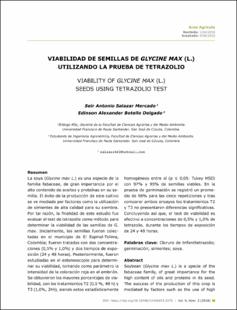Viabilidad de semillas de glycine max (l.) Utilizando la prueba de tetrazolio
Artículo de revista
2018-07-05
Revista De Investigación Agraria Y Ambiental
Bogota ,Colombia
La soya (Glycine max L.) es una especie de la familia fabaceae, de gran importancia por su alto contenido de aceites y proteínas en su semilla. El éxito de la producción de este cultivo se ve mediado por factores como la utilización de simientes de alta calidad para su siembra. Por tal razón la finalidad de este estudio fue evaluar la viabilidad de las semillas de G. max utilizando la prueba de tetrazolio. Inicialmente, las semillas fueron colectadas en el municipio El Espinal-Tolima, Colombia; las cuales se expusieron a dos concentraciones (0,5 y 1,0 %) y dos tiempos de exposición (24 y 48 horas). Posteriormente, fueron estudiadas en el estereoscopio para determinar su viabilidad, tomando como parámetro la intensidad de la coloración roja en el embrión. Se obtuvieron los mayores porcentajes de viabilidad, con los tratamientos T2 (0,5 %, 48 h) y T3 (1,0%, 24h), siendo estos estadísticamente homogéneos entre sí (p ≤ 0,05: Tukey HSD) con 97 y 95 % de semillas viables. En la prueba de germinación se registró un promedio de 96 % para las cinco repeticiones y al comparar ambos ensayos los tratamientos T2 y T3 no presentaron diferencias significativas. Concluyendo así que el test de viabilidad es efectivo a concentraciones de 0,5% y 1,0 % de tetrazolio, durante los tiempos de exposición de 48 y 24 horas. Soybean (Glycine max L.) is a specie of the
fabaceae family, of great importance for the
high content of oils and proteins in its seed.
The success of the production of this crop is
mediated by factors such as the use of high quality seeds for planting. Therefore, the
purpose of this study was to evaluate the tetrazolium test as a method to determine the
viability of G. max seeds. Initially, the seeds
were collected in the municipality of El EspinalTolima, Colombia; were treated with two concentrations (0.5 and 1.0%) and two exposure
times (24 and 48 hours). Subsequently, they
were studied in the stereoscope to determine
its viability, taking as parameter the intensity
of red coloration in the embryo. The highest
percentages of viability were obtained with the
treatments T2 (0.5%, 48 h) and T3 (1.0%, 24h), these being statistically homogeneous with
each other (p ≤ 0.05: Tukey HSD) with 97%
and 95% viable seeds. In the germination test,
an average of 96% was recorded for the five
repetitions, and when both trials were compared, the T2 and T3 treatments did not show
significant differences. Concluding that the
viability test is effective at concentrations of
0.5% and 1.0% tetrazolium, during exposure
times of 24 and 48 hours.
Descripción:
Viabilidad de semillas de Glycine max (L.) utilizando la prueba de tetrazolio.pdf
Título: Viabilidad de semillas de Glycine max (L.) utilizando la prueba de tetrazolio.pdf
Tamaño: 2.459Mb
 PDF
PDF
 LEER EN FLIP
LEER EN FLIP
Título: Viabilidad de semillas de Glycine max (L.) utilizando la prueba de tetrazolio.pdf
Tamaño: 2.459Mb
 PDF
PDF
 LEER EN FLIP
LEER EN FLIP
















